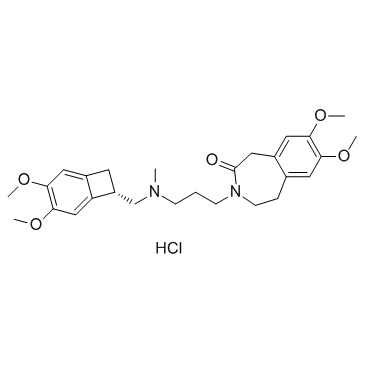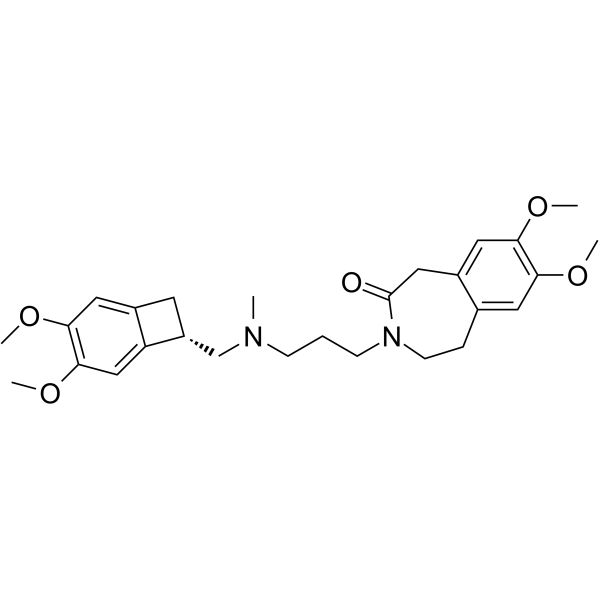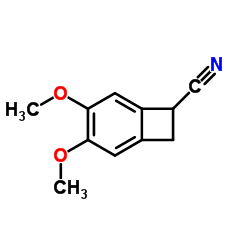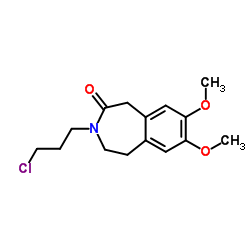Ivabradine hydrochloride
Modify Date: 2024-01-02 20:00:28

Ivabradine hydrochloride structure
|
Common Name | Ivabradine hydrochloride | ||
|---|---|---|---|---|
| CAS Number | 148849-67-6 | Molecular Weight | 505.046 | |
| Density | N/A | Boiling Point | 626.9ºC at 760mmHg | |
| Molecular Formula | C27H37ClN2O5 | Melting Point | 193-196?C | |
| MSDS | Chinese USA | Flash Point | 332.9ºC | |
| Symbol |

GHS09 |
Signal Word | Warning | |
Use of Ivabradine hydrochlorideIvabradine (hydrochloride) is a new If inhibitor with IC50 of 2.9 μM, and used as a pure heart rate lowering agent. |
| Name | ivabradine hydrochloride |
|---|---|
| Synonym | More Synonyms |
| Description | Ivabradine (hydrochloride) is a new If inhibitor with IC50 of 2.9 μM, and used as a pure heart rate lowering agent. |
|---|---|
| Related Catalog | |
| In Vivo | Ivabradine treatment (10 mg/kg/d) induces long-term HRR, and that improves diastolic LV function probably involving attenuated hypoxia, reduced remodeling, and/or preserved nitric oxide bioavailability, resulting from processes triggered early after HRR initiation: angiogenesis and/or preservation of endothelial nitric oxide synthase expression[1]. Ivabradine leads to a sustained 15-20% heart rate reduction, but has no effect on blood pressure. While ivabradine has no effect on endothelial function and vascular reactive oxygen species production in angiotensin II-treated rats, it improves both parameters in ApoE knockout mice. Ivabradine treatment leads to an attenuation of angiotensin II signaling and increased the expression of telomere-stabilizing proteins in ApoE knockout mice, which may explain its beneficial effects on the vasculature. The absence of these protective ivabradine effects in angiotensin II-infused rats may relate to the treatment duration or the presence of arterial hypertension[2]. |
| References |
| Boiling Point | 626.9ºC at 760mmHg |
|---|---|
| Melting Point | 193-196?C |
| Molecular Formula | C27H37ClN2O5 |
| Molecular Weight | 505.046 |
| Flash Point | 332.9ºC |
| Exact Mass | 504.239105 |
| PSA | 60.47000 |
| LogP | 4.04990 |
| Vapour Pressure | 1.24E-15mmHg at 25°C |
| Storage condition | -20°C Freezer |
| Precursor 9 | |
|---|---|
| DownStream 1 | |
|
Beat Rate Variability in Murine Embryonic Stem Cell-Derived Cardiomyocytes: Effect of Antiarrhythmic Drugs.
Cell Physiol. Biochem. 38 , 646-58, (2016) Heart rate variability (HRV) refers to the fluctuation of the time interval between consecutive heartbeats in humans. It has recently been discovered that cardiomyocytes derived from human embryonic a... |
| Ivabradine hydrochloride |
| AMG 998 |
| Coralan |
| Procoralan |
| Corlentor |
| 3-[3-[[(7S)-3,4-dimethoxy-7-bicyclo[4.2.0]octa-1,3,5-trienyl]methyl-methylamino]propyl]-7,8-dimethoxy-2,5-dihydro-1H-3-benzazepin-4-one,hydrochloride |
| ivabradine monohydrochloride |
| 2H-3-Benzazepin-2-one, 3-(3-((((7S)-3,4-dimethoxybicyclo(4.2.0)octa-1,3,5-trien-7-yl)methyl)methylamino)propyl)-1,3,4,5-tetrahydro-7,8-dimethoxy-, monohydrochloride |
| Ivabradine hcl |
| 2H-3-Benzazepin-2-one, 3-[3-[[[(7S)-3,4-dimethoxybicyclo[4.2.0]octa-1,3,5-trien-7-yl]methyl]methylamino]propyl]-1,3,4,5-tetrahydro-7,8-dimethoxy-, hydrochloride (1:1) |
| MFCD00929899 |
| 3-{3-[{[(7S)-3,4-Dimethoxybicyclo[4.2.0]octa-1,3,5-trien-7-yl]methyl}(methyl)amino]propyl}-7,8-dimethoxy-1,3,4,5-tetrahydro-2H-3-benzazepin-2-one hydrochloride (1:1) |
| UNII-TP19837BZK |
| Corlanor |
![3-[3-[[[(7S)-3,4-Dimethoxybicyclo[4.2.0]octa-1,3,5-trien-7-yl]Methyl]Methylamino]propyl]-1,3-dihydro-7,8-dimethoxy-H-3-benzazepin-2-one Structure](https://image.chemsrc.com/caspic/467/1086026-31-4.png) CAS#:1086026-31-4
CAS#:1086026-31-4 CAS#:155974-00-8
CAS#:155974-00-8![7,8-Dimethoxy-1,3,4,5-tetrahydrobenzo[d]azepin-2-one Structure](https://image.chemsrc.com/caspic/000/20925-64-8.png) CAS#:20925-64-8
CAS#:20925-64-8![3-chloro-N-{[(7S)-3,4-dimethoxybicyclo[4.2.0]octa-1,3,5-trien-7-yl]methyl}-N-methyl-1-propanamine Structure](https://image.chemsrc.com/caspic/412/1031767-71-1.png) CAS#:1031767-71-1
CAS#:1031767-71-1 CAS#:35202-54-1
CAS#:35202-54-1 CAS#:41234-23-5
CAS#:41234-23-5 CAS#:35249-62-8
CAS#:35249-62-8 CAS#:866783-12-2
CAS#:866783-12-2 CAS#:85175-65-1
CAS#:85175-65-1
